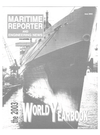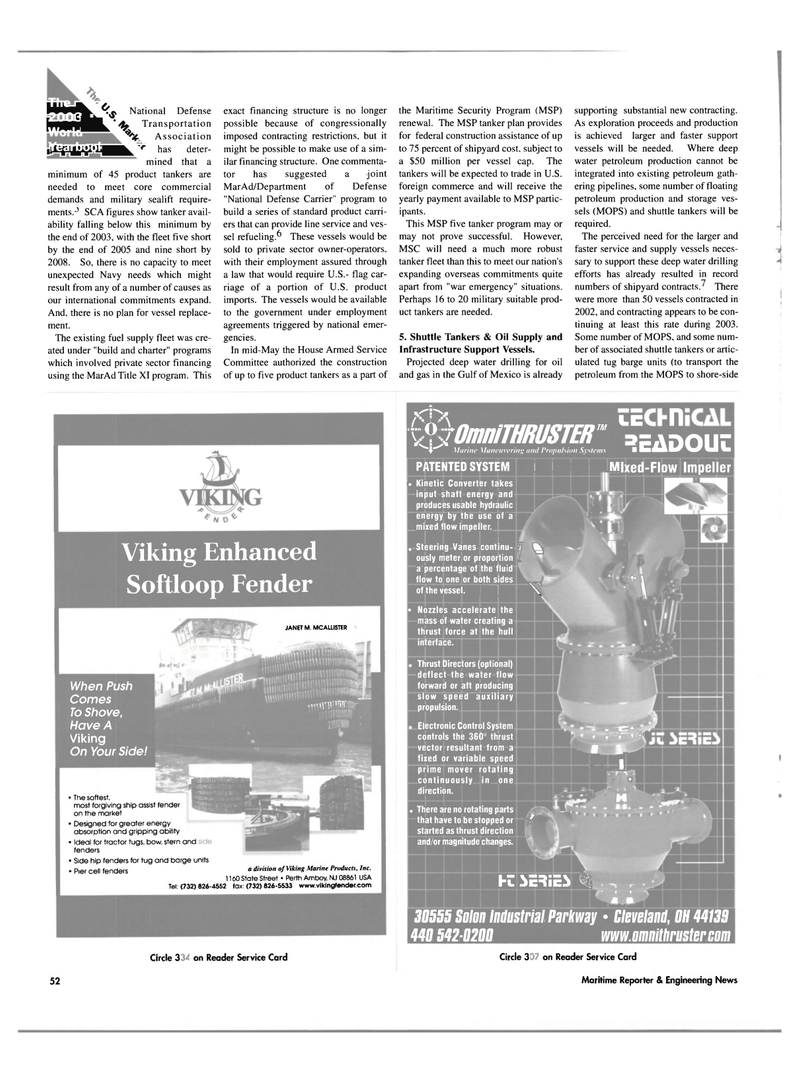
Page 52: of Maritime Reporter Magazine (June 2003)
Read this page in Pdf, Flash or Html5 edition of June 2003 Maritime Reporter Magazine
Httw^^k ^n National Defense ffJVMV^^^L. * fy Transportation \ Association j. tjL^lJi'L^^^^ has deter- mined that a minimum of 45 product tankers are needed to meet core commercial demands and military sealift require- ments.-' SCA figures show tanker avail- ability falling below this minimum by the end of 2003, with the fleet five short by the end of 2005 and nine short by 2008. So, there is no capacity to meet unexpected Navy needs which might result from any of a number of causes as our international commitments expand.
And. there is no plan for vessel replace- ment.
The existing fuel supply fleet was cre- ated under "build and charter" programs which involved private sector financing using the MarAd Title XI program. This exact financing structure is no longer possible because of congressionally imposed contracting restrictions, but it might be possible to make use of a sim- ilar financing structure. One commenta- tor has suggested a joint
MarAd/Department of Defense "National Defense Carrier" program to build a series of standard product carri- ers that can provide line service and ves- sel refueling/1 These vessels would be sold to private sector owner-operators, with their employment assured through a law that would require U.S.- flag car- riage of a portion of U.S. product imports. The vessels would be available to the government under employment agreements triggered by national emer- gencies.
In mid-May the House Armed Service
Committee authorized the construction of up to five product tankers as a part of the Maritime Security Program (MSP) renewal. The MSP tanker plan provides for federal construction assistance of up to 75 percent of shipyard cost, subject to a $50 million per vessel cap. The tankers will be expected to trade in U.S. foreign commerce and will receive the yearly payment available to MSP partic- ipants.
This MSP five tanker program may or may not prove successful. However,
MSC will need a much more robust tanker fleet than this to meet our nation's expanding overseas commitments quite apart from "war emergency" situations.
Perhaps 16 to 20 military suitable prod- uct tankers are needed. 5. Shuttle Tankers & Oil Supply and
Infrastructure Support Vessels.
Projected deep water drilling for oil and gas in the Gulf of Mexico is already supporting substantial new contracting.
As exploration proceeds and production is achieved larger and faster support vessels will be needed. Where deep water petroleum production cannot be integrated into existing petroleum gath- ering pipelines, some number of floating petroleum production and storage ves- sels (MOPS) and shuttle tankers will be required.
The perceived need for the larger and faster service and supply vessels neces- sary to support these deep water drilling efforts has already resulted in record -7 numbers of shipyard contracts.' There were more than 50 vessels contracted in 2002, and contracting appears to be con- tinuing at least this rate during 2003.
Some number of MOPS, and some num- ber of associated shuttle tankers or artic- ulated tug barge units (to transport the petroleum from the MOPS to shore-side
Viking Enhanced
Softloop Fender
JANET M. MCALLISTER
When Push
Comes
To Shove,
Have A
Viking
On Your Side! • The softest, most forgiving ship assist fender on the market • Designed for greater energy absorption and gripping ability • Ideal for tractor tugs, bow, stern and fenders • Side hip fenders for tug and barge units • Pier cell fenders -niilHVW a division of Viking Marine Products, Inc. 1160 State Street • Perth Amboy, NJ 08861 USA
Tel (732) 826-4552 fax (732) 826-5533 www.vikingfender.conn
Circle 213 on Reader Service Card %r0mniTHRUSTERm "EaSouc • Murine Maneuvering and Propulsion Systems • wmm^M^ W
PATENTED SYSTEM Mixed-Flow impeller
T^Omnil • Muneuve
M • Kinetic Converter takes input shaft energy and produces usable hydraulic energy by the use of a mixed flow impeller. . Steering Vanes continu- fe ously meter or proportion ™ a percentage of the fluid flow to one or both sides of the vessel. \
Nozzles accelerate the mass of water creating a thrust force at the hull interface.
Thrust Directors (optional) deflect the water flow forward or aft producing slow speed auxiliary propulsion.
Electronic Control System controls the 360° thrust vector resultant from a fixed or variable speed prime mover rotating continuously in one direction. . There are no rotating parts that have to be stopped or f started as thrust direction and/or magnitude changes. ' I 9 § - ££** * f * " 1 I |j • " K '
K ic^ici t r -t * m 30555 Solon Industrial Parkway • Cleveland, OH 44139 440 542-0200 www.omnithrustBr.com 52
Circle 345 on Reader Service Card
Maritime Reporter & Engineering News

 51
51

 53
53
